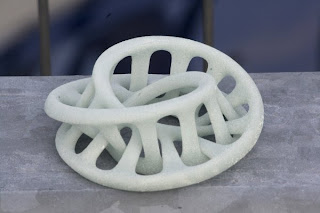>Solar Sintar
Markus Kayser – Solar Sinter Project from Markus Kayser on Vimeo.
If you have been like me, you spend every possible hour in the studio – head down, working on artwork and projects. The world, my friend, however, has been marching on. New technologies are reshaping how art is made.
In this brave new world, 3D printers top every sculptors must-have list.
The model above is Emmanuel Lattes’ Double Möbius. 3D printed in glass. Glass frit powder is mixed with a binding agent that allows the work to be modeled and built by layers in a 3D printer. The work is then carefully loaded into a kiln and fired, fusing the powder and burning away the binding agent. Tho a bit more fragile and rougher than traditional glass forming, the possibilities of computer assisted sculpture are incredible.
But to put all this progress into perspective, a little history is in order. The first 3D printer was produced by Charles Hull in 1984, who utilized a patented stereolithography method for the print process. The basic approach for 3D printing is to create a layer of polymer for the desired 2D slice, cure that area, and then repeat to build layer-upon-layer. Hull’s technique involved creating a 0.0025-inch layer of liquid photocurable polymer that could be cured with a UV laser.
In 1988, the first commercially available 3D printer was officially launched by 3D Systems, which utilized a photo-optical acrylic resin. In the early 1990s, a number of other methods were developed, including fused deposition modeling that extruded thermoplastics for layering and multi-jet modeling, based on ink-jet printer technology. Techniques have also been developed that use powder and lasers. Over time, a multitude of companies across the world have sprung up offering their high-end printers combined with CAD software and scanners, allowing objects to be either scanned or designed from scratch.
In the above video, Markus Kayser goes into the Sahara with a solar powered printer to create 3D objects – including a bowl – by melting the sand that he scoops up. What an idea for the Glass School’s bowl class! (& class outdoors!). But, you may ask, what about annealing?
Awesome to get a glimpse of the future of both sculpture and sustainable design.
For more about 3D printing – click HERE to jump to a recent article in The Economist.
